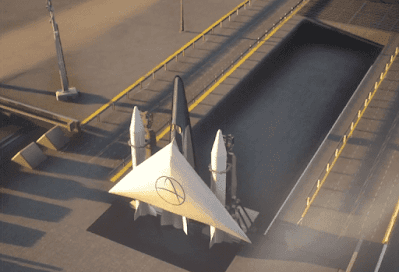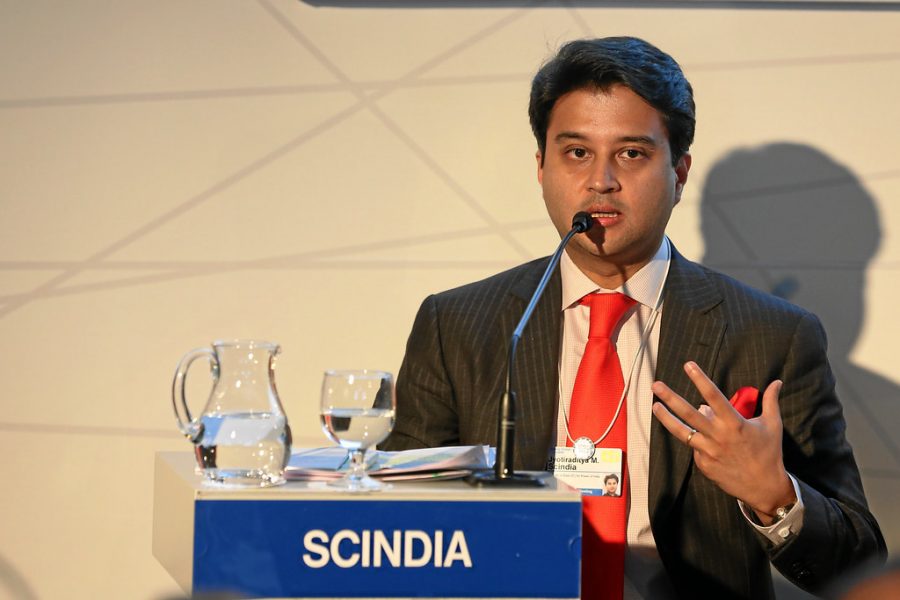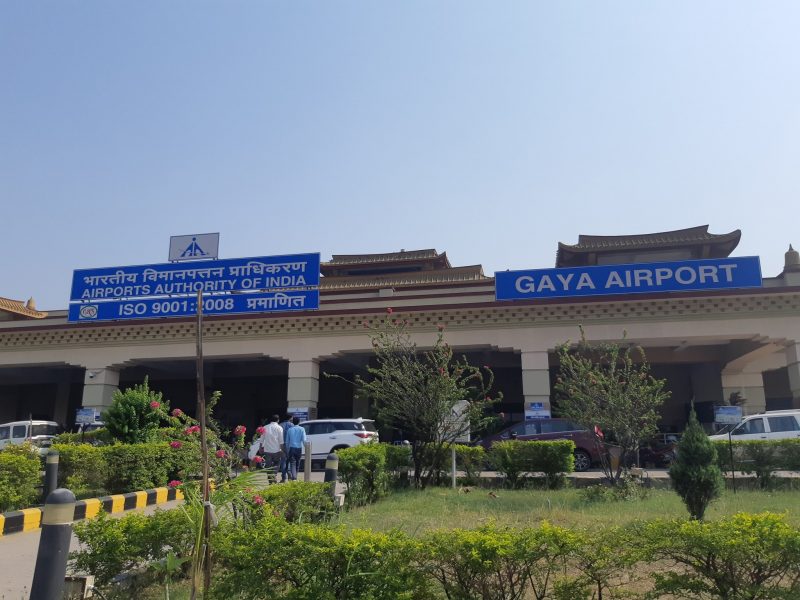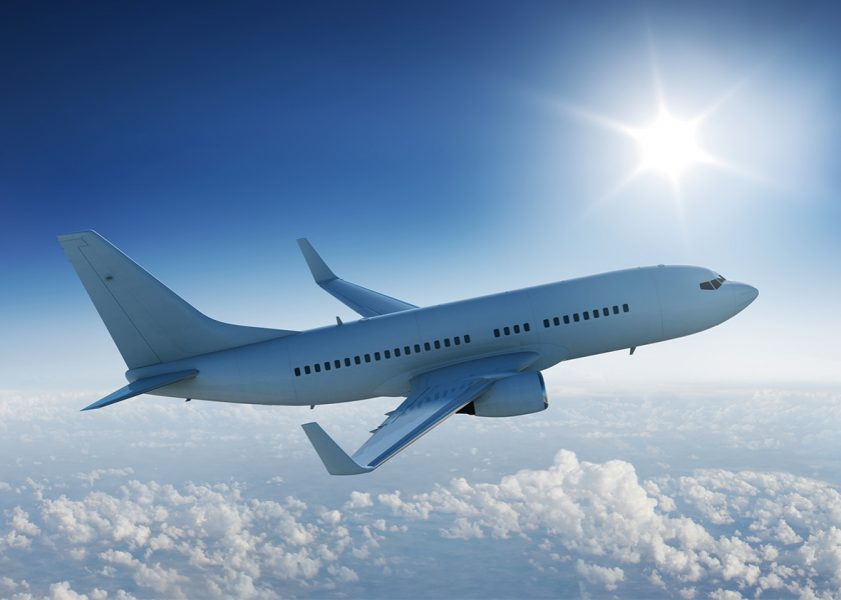Chinese hypersonic aircraft to clock speeds 9 times the speed of sound?
Prashant-prabhakar
06 Feb 2022

The faster, the better- seems to be the motto of the Chinese firm, Space Transportation, which is developing a "rocket with wings" for space tourism and point-to-point travel.
Space Transportation
We are developing a winged rocket for high-speed, point-to-point transportation, which is lower in cost than rockets that carry satellites and faster than traditional aircraft.the company said in a recent interview with Yicheng Times
Basically, a space plane is a vehicle that combines the best of a spacecraft and an aircraft, technically allowing it to function in the atmosphere and space as well.
Apparently, the "spaceplane" being developed by the company can clock 7000 kilometres in an hour at nine times the speed of sound, underlining the ambitious hypersonic capabilities of the vehicle.
According to a video presentation on Space Transportation's website, animated passengers can be seen boarding the spaceplane attached to a wing powered by rockets. The plane detaches from the rocket-powered wing following a vertical take-off and continues its suborbital journey to Dubai in the Middle East, landing vertically on three legs deployed from the rear.
Space Transportation
The Hypersonic Space-plane in the making
Tianxing 1 and Tianxing 2 are the two sub-orbital hypersonic test launch vehicles, launched by the company to conduct preliminary tests, in association with Tsinghua University’s combustion laboratory.
Tianxing 2 Y4 rocket flight test | Twitter
Owing to the sensitive nature of hypersonic technology, much of the details of the tests are classified as of now.
What is known though is that, China Aerospace Science and Technology Corporation (CASC)- the country's major space contractor, have conducted highly covert launch tests of suborbital and orbital vehicles from the Jiuquan Satellite Launch Center in 2020 and 2021, according to Space.com.
A brief history
Though it might appear as news to some, the Chinese work on hypersonic tech is not entirely new.
Chinese hypersonic wind tunnel | Asian Military Review
Space Transportation announced last August that it had raised USD 46.3 million for its hypersonic space plane plans-a hypersonic airliner that would be capable of transporting about 10 passengers to anywhere in the world in just an hour.
The company has recently been conducting several tests of its Tianxing 1 and Tianxing 2 vehicles and a 10th flight test was conducted on January 23.
There have been many reports with regards to hypersonic developments from the Chinese side, much of which have been rubbished by American experts.
Regardless, reports suggest that test flights are set to take place next year, with the first uncrewed flight in 2024 and the first crewed flight to launch the following year.
SOURCE(s)
COVER: China Transportation
Read next
Airline major InterGlobe Aviation, which operates IndiGo, on Friday, February 4 reported a standalone net profit of INR 130 crore for the quarter ending December 31, 2021, due to a rebound in travel demand during the holiday season, though fuel costs surged.
It reported a net loss of INR 620 crore in the year-ago period. Revenue from operations rose 90% to INR 9,295 crore as against INR 4,910 crore in Q3FY21.
The company said its fuel cost in Q3FY22 was at INR 3,269 crore, up 64% on a sequential basis and a 184% jump on an annual basis.
Revenue from operations rose 90% to INR 9,295 crore as against INR 4,910 crore in Q3FY21.
Total debt as of Q3-end was at INR 35,153 crore, up 27% on an annual basis, said the company, which expects Q4FY22 capacity to reduce by around 10%-15% as against Q3FY22.
Indigo's yields grew 19.2% to Rs 4.41 per kilometre at the end of December. Passenger load factor rose to 79.7% from 72% a year ago.
At the end of December 31, Indigo had 283 aircraft on its feet. This consisted of 56 A320 CEOs, 140 A320 NEOs, 52 A321 NEOs and 35 ATRs; a net increase of 4 aircraft during the quarter. It operated a peak of 1,574 daily flights during the quarter including non-scheduled flights.
At the end of December 31, Indigo had 283 aircraft on its feet.
It also provided scheduled services to 71 domestic destinations and various international locations through passenger charters and air bubble flights.
Aircraft fuel expenses surged 186% to Rs 3,269.30 crore while aircraft and engine rentals advanced 98% to Rs 127.30 crore. Total expenses increased 62% to Rs 9346.40 crore. EBITDA margin improved to 21.5% from 20.1% a year ago.
"I am pleased that we were able to report a profit for the third quarter. It demonstrates that our business model is fundamentally strong.Our employees have remained a pillar of strength throughout this health crisis and have steadfastly provided superior service to our customers."Ronojoy Dutta, CEO, IndiGo
On Friday, February 4, the company's scrip on BSE closed 1.5% higher at INR 1,969.
InterGlobe Aviation's new Managing Director
The company also announced the appointment of its co-founder Rahul Bhatia as the company's Managing Director with immediate effect. The company is the parent of the country’s largest airline IndiGo. Bhatia is the Co-founder and Promoter of InterGlobe Aviation.
"The Board of Directors have unanimously approved the appointment of Rahul Bhatia, currently a Non-Executive Director, as the Managing Director of the Company effective 4 February 2022," said InterGlobe Aviation in a stock exchange filing.
Rahul Bhatia, Managing Director, InterGlobe Aviation
Bhatia said his agenda would be transformational and would focus on expanding the airline's presence in India and international markets and building for the long term.
IndiGo Chairman Meleveetil Damodaran said the move will further strengthen the airline in the years ahead. Bhatia would oversee all aspects of the airline, and actively lead the management team, he added.
Bhatia, who holds an electrical engineering degree from the University of Waterloo in Ontario, Canada, is the vice-chairman and promoter of InterGlobe Enterprises Ltd. He has over three decades of experience in the travel industry.
The appointment marks the next phase for the carrier that saw Bhatia feud with the other founder, Rakesh Gangwal, over share-transfer restrictions and governance issues.
In 2011, Bhatia was awarded as the ‘Entrepreneur of the Year’ by Ernst & Young. In 2016, he was featured on the Forbes’ Global Game Changers List.
The appointment marks the next phase for the carrier that saw Bhatia feud with the other founder, Rakesh Gangwal, over share-transfer restrictions and governance issues.
The legal battle ended with an international arbitrator asking Gangwal to pay Bhatia USD 50,000 claim, and allowing his counterclaim seeking removal of restrictions of a share sale by founders. The two own 74.44% of the airline bet
Read next
Air India's operating costs are now available for infrastructural spending - Jyotiraditya Scindia
Radhika Bansal
05 Feb 2022

In an interview with CNBC-TV18, Union Minister for Civil Aviation Jyotiraditya Scindia said the Air India sale was a win-win deal for all stakeholders.
The minister said Air India was running a loss of INR 20 crore a day -- that's INR 7.5 thousand crores a year and said that over INR 2.5 lakh crore had been infused just to keep the airline afloat.
"So, from the point of view of millions of taxpayers, I think this money can now be spent much more judiciously in infrastructure," Scindia said.
Air India's operating costs are now available for infrastructural spending.
He said the government has stopped throwing good money after bad just to keep the airline afloat. He said it was extremely important in a hugely growing market like India, which has close to about 144 million fliers per annum, that you see multiple players with a value proposition.
"The airline sector in India, a space that is extremely fragmented, will see the rise of another player with considerable market share, an industry which had a dominant market leader will now see a lot of competition," Scindia said.
InterGlobe Aviation runs India's largest airline, IndiGo. He said the Tatas had the marketing plan in place.
Jyotiraditya Scindia, Union Minister of Civil Aviation
"I have seen and heard through multiple print and electronic media over the last couple of weeks that they (Tatas) have a financial plan in place, a strategic plan in place, a human resource element to their strategy, as well as a marketing element. I think all of that together is a clarion call for a new product to be out," he said.
Scindia said the sector already has five or six players and for the first time after almost about a decade, two new players will enter.
"One is a rebirth in the form of Jet and the second is an Akasa. I wish them all the very best. I am hopeful that by the upcoming second and third quarters, you will see both the entrance, unveiling their product and their value proposition in this market," he added.
The Air India deal was a win-win transaction for the government
Indicating there would be a huge upside in the aviation sector in days to come, Scindia said the government was working on the next tranche of airports under the public-private partnership. He reiterated the Air India deal was a win-win transaction for the government because it gets reimbursed for the investments it has put into airports to date.
"For example, for the six airports that have been leased out in the past round we have received INR 2,249 crore upfront, in addition to per pax royalty that will be paid for each airport going forward," he said.
(With Inputs from CNBC TV18)
Read next
From the vault | The Dassault Mercure - an era before the B737 and A320
Prashant-prabhakar
05 Feb 2022
Having been proposed as a French counterpart to the American Boeing 737 and Douglas’ DC-9, the "Dassault Mercure" was developed and manufactured by French aircraft firm Dassault Aviation.
Developed at a time when France was stepping up its game as global aviation power, it was Dassault's first venture into the commercial jet airliner market. Introduced at the beginning of the jet age, the "Sud Aviation Caravelle" - a twin-engine short and medium-haul airliner and the "Nord-262 propjet" were France's give-away to aviation.
Sud Aviation Caravelle | Wikipedia
Touted to be the next big thing, and despite being a favourite among pilots and passengers alike, the "Mercure" programme failed to take off successfully and soon faded into oblivion.
The beginning and the end
The programme "Mercure" was officially launched in April 1969. Manufacturing to be carried out under the main contractors of Dassault was shared between Fiat (Italy), CASA (Spain), ADAP (Belgium), the federal aircraft builder FW of Emmen (Switzerland) and Canadair (Canada). This was the first large-scale European cooperation programme in civil aeronautics.
The Dassault Mercure was a twin-engine narrow-body powered by two wing-mounted Pratt&Whitney JT 8 D 15 double-flow engines, very much similar to the contemporary Boeing 737-200 although slightly bigger and heavier.
Dassault Mercure | Dassault Aviation
I wanted to name it for a mythological figure and I could only think of one who had wings on his helmet and ailerons on his feet – hence the name Mercure (Mercury).Marcel Dassault, Founder and Owner, Dassault Aviation
Marcel Dassault | Dassault Aviation
The prototype of the Mercure 100 made its maiden flight from Mérignac (Gironde, France) on 28th May 1971 with a crew including Jean Coureau, chief pilot, Jérôme Résal, pilot, and Gérard Joyeuse, test engineer.
On 2nd June, the aircraft arrived at the Paris Air Show for its 6th flight and with only 9 hours of test flights.
At the time, the largest 737 could seat 136 passengers, while the DC-9 was even smaller, with a limit at just 125. Therefore, the Mercure decided to be marketed as a large aircraft for high-demand short-haul routes, something the two American giants hadn’t yet developed.
However, despite the new airliner’s excellent pedigree and its manufacturer’s high hopes, the biggest difference between the Mercure and the Boeing 737-200 was the range. The aircraft could travel just 1,700 kilometres - thereby allowing the Mercure to operate brilliantly in western Europe.
However, it failed to flourish in its ultimate target market-the United States which wasn’t compatible with the short-range jet.
The aircraft was also disadvantaged because of its engines: its Pratt & Whitney engines were relatively old, noisy and fuel inefficient. To remedy the situation, Dassault designed a new version of the Mercure – the Mercure 200 – with two Snecma/General Electric CFM 56 engines.
Tech and Specs
The Mercure was the first airliner to have a Head Up Display (HUD) for pilots, which allowed take-offs with forward visibility (RVR – Runway Visual Range) as low as 100 metres (328 feet).Source
DASSAULT MERCURE 100 2D panel | HUD | HJG Message Boards-Proboards
It intentionally exchanged fuel for passenger capacity to carry a greater passenger load; as such, the Mercure had up to 17 per cent more seats than the competing Boeing 737 while having a shorter range.
Dassault Mercure six-abreast cabin | Flickr
With engines tucked under its wings, its nose and fuselage had a distinctly modern look.
The cockpit was fitted with two instruments that remain unique among civil transports: an Angle Of Attack (AOA) indicator used to illustrate lift generated by the wing, which allowed pilots to fly visual approach speeds accurate to within a single knot, and a G meter to avoid exceeding airframe structural limits (which were +2.5G and -1G).
Air Inter - the only airline to order the Dassault Mercure
On 30 January 1972, Air Inter placed an order for ten Mercures, which had to be delivered between 30 October 1973 and 13 December 1975.
Dassault Mercure 100 | Wikimedia Commons
The Mercure was so carefully tailored to the needs of domestic-only Air Inter that it was crippled by a maximum range of only 2,000 kilometres (1,295 miles), and, with maximum payload, only 1,000 kilometres (621 miles).Source
On 29 April 1995, the last two Mercures in service flew their last commercial flights.
At the time of their retirement, they had an impressive track record- logging in 360,000 flying hours, transporting 44 million passengers in 440,000 flights and with a 98% in-service reliability, with zero accidents.
SOURCE(s)
COVER: AirHistory.net
Read next
Gaya Airport's 'GAY' Code is Inappropriate; Panel asks centre to change it
Radhika Bansal
05 Feb 2022

A Parliamentary panel on Friday, February 4 said the use of the 'GAY' code for Gaya airport is inappropriate for the holy city and asked the government to make all efforts to change the code.
The Committee on Public Undertakings, in its first report tabled in Parliament in January 2021, had recommended changing the code of Gaya airport from 'GAY' and also suggested an alternate code name like 'YAG'.
According to the civil aviation ministry, IATA has expressed its inability to change the code without a "justifiable reason primarily concerning air safety".
The International Air Transport Association (IATA) assigns the code for airports.
The International Air Transport Association (IATA) assigns the code for airports. The committee said the code name appeared inappropriate, unsuitable, offensive and embarrassing considering that Gaya is a holy city.
In an action taken report tabled in Parliament on Friday, February 4, the panel mentioned the issue and has asked the government to "make all effort to take up the matter with the IATA and concerned organisation as the issue involves inappropriate code naming of an airport of a holy city of our country." The ministry, in its action taken to reply, has submitted that the matter was referred to IATA by Air India.
In this regard, IATA stated that as per Resolution 763, the location codes are considered permanent and a strong justification primarily concerning air safety needs to be given.
Gaya Airport's 'GAY' Code is Inappropriate
"Gaya airport IATA code 'GAY' has been in use since operationalisation of Gaya airstrip. Hence, without a justifiable reason primarily concerning air safety, IATA has expressed its inability to change the IATA code of Gaya airport," the ministry told the panel.
The ministry's reply has been mentioned in the panel's report tabled on Friday, February 4.
"The committee appreciates the efforts of Air India being a member airline of IATA taking up the request with the international air transport association but, yet, re-emphasise the government also to make all effort to take up the matter with the IATA...," the report said.
In the first report that was tabled in Parliament in January 2021, the panel had mentioned that it was apprised about a request received by the civil aviation ministry regarding the change of code name of Gaya airport.
The panel had also recommended that the government and Air India complete all the requisite consultations and formalities in a time-bound manner to change the code name of Gaya airport.
Read next
Parliamentary panel slam aviation ministry over AAI for falling short of global standards in aviation safety and security
Radhika Bansal
05 Feb 2022

A key parliamentary committee has rapped the Ministry of Civil Aviation over the Airports Authority of India (AAI) lagging behind global standards in two critical elements of aviation safety and security measures, according to a report by The Tribune India.
“Out of eight critical elements, AAI is lagging behind ineffective implementation in two critical elements—organisation and licensing, which is 61.54% and 25.26%, respectively, against the world average score of 70.8%,” the Committee on Public Undertakings has stated in its report on AAI tabled in Parliament.
ICAO requires its member states to establish and implement an effective state oversight system for aviation safety and security.
The other six critical elements, as mandated by the International Civil Aviation Organisation (ICAO), are legislation, operations, airworthiness, accident investigation, air navigation services and aerodromes. ICAO requires its member states to establish and implement an effective state oversight system for aviation safety and security by taking into account the eight elements.
The Committee observed that while AAI’s overall effective implementation score of 70.8% was a notch above the world average of 69.76%, it trailed by a wide margin in the organisation and licensing where the world average was 71.14% and 73.55%, respectively.
The Committee had earlier expressed concern that India, which is one of the major civil aviation markets after the US and China, was lagging far behind in the effective implementation of the two critical elements.
Pointing out that AAI had not been able to keep pace with global standards, the Committee had expressed apprehensions that it may deter foreign investments in the civil aviation sector and thereby adversely affect the sector’s expected growth.
The Ministry of Civil Aviation had stated before the Committee that licensing covered pilots, flight engineers, ground personnel, air traffic controllers and aerodromes.
All AAI airports used for international operations and all AAI domestic airports operating scheduled air transport services are licensed by the Directorate General of Civil Aviation (DGCA) and hence effective implementation in licensing on part of AAI was 100%. Poor percentage of effective implementation in this area may be attributed to other licensing areas, the ministry said.
The Committee however pointed out that the ministry had only elaborated the reasons for poor performance only in respect of licensing and was conspicuously silent on the other critical element of the organisation. Even while talking about licensing, the ministry only referred to aerodromes and left out other components such as personnel.
While seeking elaborate reasons for poor performance in the two critical elements, the committee stressed that the central government should take suitable steps not only to reach world averages but also to be on par with the best in the world.
(With Inputs from The Tribune India)


Comment